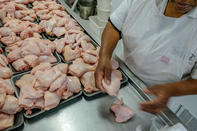
Whole Birds

Whole birds are available at retailers with and without giblets. (Giblets is the term used for the combination of the gizzard, kidney, heart, liver and neck).
When buying a whole chicken with giblets, the giblets are usually wrapped in a plastic bag within the chicken. The bag with giblets should be removed before cooking the bird.
Chicken can be cooked whole or split along the backbone (spatchcocked). Whole birds can be marinated and stuffed before being roasted or baked. The spatchcocked chicken is marinated and then grilled, oven roasted or barbecued.
Wings

Breast and Tenderloin

The breasts and tenderloins have white meat with very little fat. The tenderloins are slightly softer than the whole breast. The breasts and tenderloins can be baked, poached, grilled, over roasted, pan-fried used on its own, in salads, soups or stews.
It can be bought without the skin or with the wingettes (wings cut apart at the joint) attached and skin on.
Legs

Offal

The liver is a good source of iron and protein and can be pan-fried with garlic and other herbs to produce liver pate. It is also suited for deep frying. Nose to Tail recommends the soaking of the liver in buttermilk or acidified water before cooking to lighten the taste.
The rest of the giblets, the gizzard, heart and kidneys, can be boiled to produce stock or gravy, or it can be deep fried. Don’t add the liver while making the stock, as it will give the stock a bitter taste.
The gizzard is high in iron, vitamins A and C, calcium, sodium and potassium, while the heart is a good source of protein, iron vitamin B12, folate and zinc. The kidneys, according to Nose to Tail, contain melatonin receptors which have been known to fight aging as well as cancer. It is used in some speciality French and Chinese dishes.
The cockscomb is gelatinous, containing small amounts of proteins and amino acids. They are popular ingredients in Chinese dim sum and Italian Cibreo. The testicles contain protein, sodium, potassium, iron, zinc, phosphorous and magnesium and are used in broths and stews.
Combs and testicles should be cleaned and boiled to peel the skin off before they are cooked. Chicken feet are packed with protein, calcium, collagen and cartilage. They can be deep fried or boiled to produce a broth or stock. The skin should be pulled from the feet before cooking.
By Glenneis Kriel